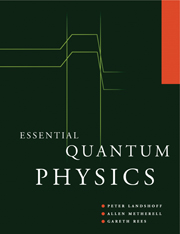Book contents
- Frontmatter
- Contents
- Preface
- Constants of quantum physics
- 1 Preliminaries
- 2 The Schrödinger equation
- 3 Special solutions
- 4 The superposition principle
- 5 The hydrogen atom
- Revision quiz
- 6 The hydrogen molecule
- 7 Introduction to perturbation theory
- 8 Spin
- 9 Masers and lasers
- 10 Band structure of crystals
- 11 Electron motion in crystals
- 12 Transistors
- Appendices
- Hints for the problems
- Index
10 - Band structure of crystals
Published online by Cambridge University Press: 05 June 2012
- Frontmatter
- Contents
- Preface
- Constants of quantum physics
- 1 Preliminaries
- 2 The Schrödinger equation
- 3 Special solutions
- 4 The superposition principle
- 5 The hydrogen atom
- Revision quiz
- 6 The hydrogen molecule
- 7 Introduction to perturbation theory
- 8 Spin
- 9 Masers and lasers
- 10 Band structure of crystals
- 11 Electron motion in crystals
- 12 Transistors
- Appendices
- Hints for the problems
- Index
Summary
Electrons in crystals
A crystal consists of a collection of atoms arranged in a regular array, the spacing between atoms being of the same order of magnitude as the dimensions of the atoms. Each atom is more or less anchored to one point, called its site in the lattice, by the electrostatic forces produced by all the other atoms. We shall not find it necessary here to discuss the details of how this comes about; nor shall we consider the various patterns in which the atoms can be arranged. It will be sufficient to remember the essential feature that the structure of the crystal is periodic in space.
We have seen in chapter 5 that the energy of an electron bound to an atom is restricted to certain discrete values. Imagine that we can assemble a crystal of identical atoms whose spacing L can be altered at will. If L is large enough, the motion of an electron in one of the atoms will be affected to a negligible extent by the electrons and nuclei of the other atoms. Each atom then behaves as if it were isolated, with its electrons in discrete bound states. In figure 10.1 (a) we have drawn a schematic diagram of the potential V(r) in which an electron moves in this situation. Suppose that the spacing L is now reduced (figure 10.1(b)). The potential V(r) in the neighbourhood of a given atom is now affected by the presence of the nuclei and electrons of the other atoms, particularly those that are closest.
- Type
- Chapter
- Information
- Essential Quantum Physics , pp. 112 - 125Publisher: Cambridge University PressPrint publication year: 1997



